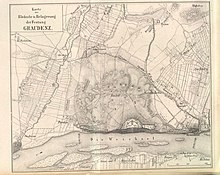Siege of Graudenz
| Siege of Graudenz | |||||||
|---|---|---|---|---|---|---|---|
| Part of the War of the Fourth Coalition | |||||||
 Map of the siege of Graudenz in 1807 | |||||||
| |||||||
| Belligerents | |||||||
|
| |||||||
| Commanders and leaders | |||||||
|
|
| ||||||
| Strength | |||||||
|
Variable 7,000[1] | 4,500[1]–5,709 men[2] | ||||||
| Casualties and losses | |||||||
| Unknown |
761 dead 88 captured 53 missing 826 deserted [2] | ||||||

125miles
The siege of Graudenz or siege of Grudziądz was a siege during the Napoleonic Wars between 22 January and 11 December, 1807. As part of the War of the Fourth Coalition the Prussian fortress at Graudenz in West Prussia in the Prussian Partition of Poland (now Grudziądz, Poland) was besieged by forces of the French Empire and its allies. The garrison, commanded by General Wilhelm René de l'Homme de Courbière, withheld blockade and siege for some 11 months, long past the formal Peace of Tilsit. The French abandoned the siege after the borders between Prussia and the new Duchy of Warsaw were defined; Graudenz/Grudziądz staying a Prussian possession until Poland regained independence after World War I.
The Polish 2nd, 4th and 7th Infantry Regiments took part in the battle on the side of Napoleon.[3]
See also
Notes
- ^ a b c d Bodart 1908, p. 385.
- ^ a b Fischer 1907, p. 54.
- ^ Gembarzewski, Bronisław (1925). Rodowody pułków polskich i oddziałów równorzędnych od r. 1717 do r. 1831 (in Polish). Warszawa: Towarzystwo Wiedzy Wojskowej. pp. 53–55.
References
- Bodart, Gaston (1908). Militär-historisches Kriegs-Lexikon (1618-1905) (in German). Retrieved 23 June 2021.
- Fischer, Paul (1907). Feste Graudienz 1807 unter Gouverneur de Courbiere - Geschichte der Blockade und Belagerung (PDF) (in German). Graudenz: Verlag Arnold Kriedte.
External links
 Media related to Siege of Graudenz at Wikimedia Commons
Media related to Siege of Graudenz at Wikimedia Commons
